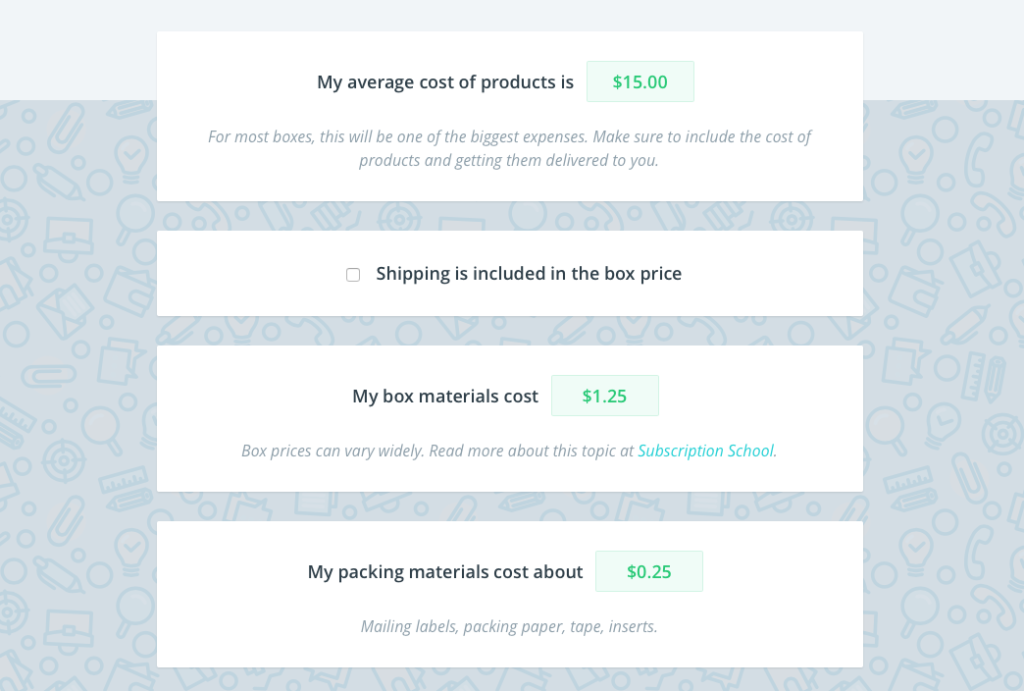Let’s cut to the chase – starting a subscription box is like any other entrepreneurial endeavor. It takes hard work, commitment, and follow-through. And just like opening a brick & mortar shop or launching an ecommerce empire, subscription boxes have their own set of challenges.
This guide will cover:
- Not validating your idea
- Pricing your box incorrectly
- Offering too many subscription options
- Cutting costs on marketing/branding
- Communicating with customers
From pricing to customer service to executing a less-than-stellar launch, here are the top pitfalls to avoid when starting a subscription box business.
Starting the Business without Validating the Idea
Even if you think you have a great idea for a subscription box business, it’s important to validate it before jumping in headfirst.
When I talk to subscription business owners who have gathered no data on product market fit and consumer interest ahead of time, it worries me. The craze behind a “subscription for everything” might lead you to thinking you have a good idea. But trust me, you’ll need more data than that before launching a business.
Jesse Richardson, Subscription School

Here are some fairly easy ways to gather data before committing fully to the business:
Prelaunch Campaign
To validate an idea, set up a landing page with a description of your subscription box idea and a signup form. Then purchase $100 of Google, Instagram or Facebook ads that direct people to your landing page. Make sure to use a few ads with different text to see what works best! If you can get people to click on your ad and then submit their email address, that’s a pretty good indication your idea is worth investing in.
Get Feedback from Real People
Friends and family can be a good source of general feedback. Ask, “Would you purchase this box or do you know someone who would?” (If they say yes, collect the cash on the spot!) Your family and friends are biased, of course, but they may also bring up points you hadn’t thought about.
Reddit, on the other hand, is a good place to get feedback from strangers. If you post your idea in the Entrepreneur subreddit, you can be assured of someone’s unvarnished opinion – good or bad.
Do Competitor Research
Have other people tried your same subscription box idea and failed? If so, see if you can get in touch with the founders and ask for advice.
Are there other competitors in the market that are successful? Make sure your brand and product will be differentiated enough to compete.
TL;DR Get real data and feedback before launching your business.
Pricing Too Low

At Cratejoy, sellers are asked to fill out a survey if they decide to close their shop. One of the top reasons sellers quit is because they are not making enough profit. Surprisingly, this happens even with companies that have a hundred or more subscribers!
It’s very easy to underestimate the costs associated with running a business. A subscription box shouldn’t be priced based on the cost of the products alone. There’s also packaging, transaction fees, taxes, marketing and other ongoing business expenses to think about.
It’s also very important to make sure the cost of your time and labor is valued at a fair rate. If your business is not making any profit, it will be very difficult to justify the time you spend on it.
So, how much should you charge for your box?
One of the easiest ways to price your subscription box with confidence is with the Cratejoy pricing guide calculator. This tool allows you to input the costs associated with running your business and then recommends a minimum price for your box.
Once all the information is filled out, the calculator will also show you how much profit to expect each month with the subscriber count you select.
TL;DR You should probably charge more.
Unnecessary Complexity
When starting a subscription business, it might seem natural to give your subscribers as many options and as much variety as possible. But multiple shipping schedules, tiered boxes, and specialty upgrades will make your job more complex and may also overwhelm the customer.
Ask yourself: do you really need 2 box sizes, 3 dietary options, an optional shirt, and 2 forms of postage offered at launch? Probably not.
Jesse Richardson, Subscription School
When you’re first learning how to source products and nail down a shipping schedule, it’s ideal to perfect the process with just one product. Launching with 15 box options is a surefire way to set yourself up for failure and burn yourself out before you’ve found a process that works.
“If this is a new subscription box, and a new business, there’s enough complexity because of that. No need to add more.”
Ben Hubbard, Director of Operations at Cratejoy
Starting with one box also allows you to gauge what your entire subscriber base wants moving forward. This helps you make educated decisions about growth and additional offerings, rather than taking the “see what sticks” approach.
TL;DR Keep it simple.
Skimping on Design and Marketing

Once you’ve settled on your products, materials, and price point, it’s time to build your brand.
This step is critical. For subscription business that fail to create a social media presence or have low-quality product photography, they will almost certainly fail to gain the kind of attention and traction they want.
After all, subscriptions offer a unique opportunity to give your customers a new experience month after month, but the first impression a potential subscriber has with your brand can kill the customer journey before it even starts.
TL;DR Plan to spend some time and money on design and marketing. Take good photos.
Bad Communication
With subscription commerce, there’s an opportunity to build a relationship with customers month over month. And as cliche as it sounds, the real key to building this relationship is good communication.
Ben Hubbard, Director of Operations at Cratejoy, said it’s common for sellers to have shipping issues their first month. During launch, the whole process is new, and it’s easy to underestimate the time required to get products, pack boxes, print labels, and get shipments out the door. Hubbard said the worst thing a seller can do in this situation is to stop communicating.
If a seller sends their customers an email to explain a shipping delay, customers are going feel slight disappointment in a delay, but that’s way better than the feelings of fear and concern a customer will have if a seller stops communicating entirely.
Ben Hubbard, Director of Operations at Cratejoy

Sellers should also be proactive about getting customer feedback even if there’s not an obvious problem. Dan Drewno, a Product Manager at Cratejoy, says, “Feedback allows sellers to rescue a customer if they’ve had a bad experience or didn’t like a specific product. By the time they cancel, it’s too late to win them back.”
Cratejoy provides tools to survey customers after each shipment. Customers can leave a simple star rating and also provide feedback about how they enjoyed the box. This shouldn’t come as any surprise, but improving feedback ratings greatly improves returns for the business.
Great feedback ratings correlate directly with higher retention, and high retention is the bedrock of nearly every successful subscription business.
Dan Drewno, Product Manager at Cratejoy
Our blog has more information about the importance of customer feedback, including customer data and graphs.
TL;DR Talk with your customers.
So what next?
Now that you know what NOT to do when starting your box, we recommend checking out our guide “How to Start a Subscription Box Business.” There you’ll find 8 simple steps for getting your idea off the ground and into the hands of your subscribers. For more tips, tricks, and resources on all things subscription commerce, head on over to Subscription School.


